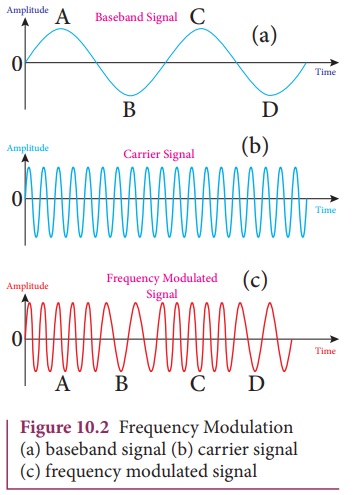Advantages, Limitations, Modulated Waveform Signals - Frequency Modulation (FM) | 12th Physics : UNIT 10b : Communication Systems
Chapter: 12th Physics : UNIT 10b : Communication Systems
Frequency Modulation (FM)
FREQUENCY MODULATION (FM)
The frequency of the carrier signal is modified in proportion to
the instantaneous amplitude of the baseband signal in frequency modulation. Here the amplitude and the phase of the carrier signal remain
constant. Increase in the amplitude of the baseband signal increases the
frequency of the carrier signal and vice versa. This leads to compressions and
rarefactions in the frequency spectrum of the modulated wave as shown in Figure
10.2. Louder signal leads to compressions and relatively weaker signals to
rarefactions.

When the amplitude of the baseband
signal is zero in Figure 10.2(a), the frequency of the modulated signal is the
same as the carrier signal. The frequency of the modulated wave increases when
the amplitude of the baseband signal increases in the positive direction (A,
C). The increase in amplitude in the negative half cycle (B, D reduces the
frequency of the modulated wave (Figure 10.2(c)).
When the frequency of the baseband
signal is zero (no input signal), there is no change in the frequency of the
carrier wave. It is at its normal frequency and is called as centre frequency or resting frequency. Practically
this is the allotted frequency of the FM transmitter.
Advantages of FM
• Large decrease in
noise. This leads to an increase in signal-noise ratio.
• The operating range is quite large.
• The transmission efficiency is
very high as all the transmitted power is useful.
• FM bandwidth covers the entire
frequency range which humans can hear. Due to this, FM radio has better quality
compared to AM radio.
Limitations of FM
• FM requires a much wider channel.
• FM transmitters and receivers are
more complex and costly.
• In FM reception, less area is
covered compared to AM.
Related Topics